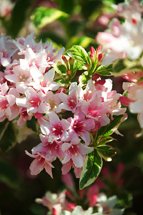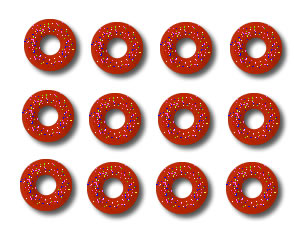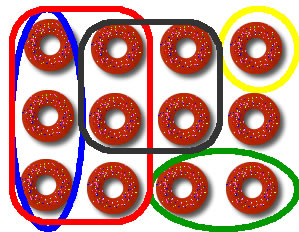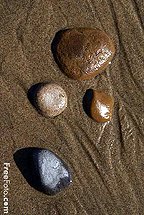| swiss-algebra-help.com |
 |
|
Algebra factoringAlgebra factoring involves an understanding of the two fundamental arithmetics steps of multiplication and division. Because not even these steps are always self-explanatory, imagine that multiplicaption means "copying" and dividing means "cutting" (an idea by the Italian primary teacher Camillo Bortolato) So, for instance, the number 12 can be seen in this way: a set of 12 doughnuts
Then, you can think of all possible way of sharing the 12 doughnuts with one or more friends, so dividing them ("cutting" them) in groups of 1, 2, 3, 4 or 6...
Eventually, you realize that the number 12 can be seen as 12= 6 x 2 = 6 + 6 Well, all the numbers which "make up" (by multiplication, i.d. "copying") the number 12 are factors of the number 12. Factors are also called divisors. So, 1,2,3,4,6 are factors (or divisors) of the number 12!
Algebra factoring implies to find the factors (also called divisors) of an integer. To factor means to write an integer (or an expression) as a product. e.g. 12 = 4 x 3 A special case of algebra factoring is when we don't find many factors for a number but just two: 1 and the number itself: For example: 2 = 1 x 2 = 1 + 1 3= 1 x 3 = 1 + 1 + 1 5= 1 x 5 = 1 + 1 + 1 + 1 + 1 7= 1 x 7 = 1 + 1 + 1 + 1 + 1 + 1 + 1 Well, these special numbers are called prime numbers. All other numbers which do have more factors are called composite numbers instead. A (positive) integer larger than 1 which has only itself and the number 1 as factor is called prime number. e.g.: 2, 3, 5, 7, 11, 13, 17, 23, 27.....(for more click here ) Prime numbers are very important numbers because, (that's really fascinating!) all whole numbers of the universe are either prime numbers or are built by them! Whole numbers which have more than two factors (including 1 and themself) are called composite numbers. e.g. 4, 6, 8, 9, 10, 12, 14, 15, 16, 18, etc...
When you want to express a number as a multiplication of prime numbers what you do is actually called a prime factorization of integers. Eventually, when you carry on factorizing numbers, and you happen to lay before you the results, you notice something evident:
Well, you see that numbers have common factors! That's an important conclusion in algebra factoring. Dealing with these common factors lead in fact to the very important concept of the Greatest Common Factor and the Least Common Multiple (and so the Least Common Denominator or LCD of a fraction).
CHAPTER VI STUDY AND RESEARCH IN MATHEMATICS 601. The first thing to be attended to in reading any algebraic Study and Difficulties of Mathematics (Chi-
Source: Memorabilia mathematica; or, The philomath's quotation-book - Moritz, Robert Édouard, 1868-1940
From algebra factoring back to homepage
|
On the shore of a vast sea
|
|
|
Stay in touch with nature. It's full of mathematics! 
Enjoy This Site?
Then why not use the button below, to add us to your favorite bookmarking service? |
||
|
| Homepage| About Us |Study Tips |Contact | This Website is Powered by Site Build It! - and I would never use anything else.
|
||
|
| ||



